 Weird Stuff
Weird Stuff  Weird Stuff
Weird Stuff  Our World
Our World 10 Ways Your Christmas Tree Is More Lit Than You Think
 Movies and TV
Movies and TV The 10 Coolest Stars to Set Sail on The Love Boat
 History
History 10 Things You Didn’t Know About the American National Anthem
 Technology
Technology Top 10 Everyday Tech Buzzwords That Hide a Darker Past
 Humans
Humans 10 Everyday Human Behaviors That Are Actually Survival Instincts
 Animals
Animals 10 Animals That Humiliated and Harmed Historical Leaders
 History
History 10 Most Influential Protests in Modern History
 Creepy
Creepy 10 More Representations of Death from Myth, Legend, and Folktale
 Technology
Technology 10 Scientific Breakthroughs of 2025 That’ll Change Everything
 Weird Stuff
Weird Stuff Ten Bizarre Facts About The Doge Meme
 Our World
Our World 10 Ways Your Christmas Tree Is More Lit Than You Think
 Movies and TV
Movies and TV The 10 Coolest Stars to Set Sail on The Love Boat
Who's Behind Listverse?

Jamie Frater
Head Editor
Jamie founded Listverse due to an insatiable desire to share fascinating, obscure, and bizarre facts. He has been a guest speaker on numerous national radio and television stations and is a five time published author.
More About Us History
History 10 Things You Didn’t Know About the American National Anthem
 Technology
Technology Top 10 Everyday Tech Buzzwords That Hide a Darker Past
 Humans
Humans 10 Everyday Human Behaviors That Are Actually Survival Instincts
 Animals
Animals 10 Animals That Humiliated and Harmed Historical Leaders
 History
History 10 Most Influential Protests in Modern History
 Creepy
Creepy 10 More Representations of Death from Myth, Legend, and Folktale
 Technology
Technology 10 Scientific Breakthroughs of 2025 That’ll Change Everything
10 Times Art Restoration Resulted In Destruction
Art restoration is one of those professions that requires a great deal of knowledge and skill to be done correctly. Restoring a painting, statue, or structure often requires an understanding of various art techniques, but also chemistry, architecture, and many more subjects.
When it’s done well, the public is none the wiser, but if it’s done terribly by unqualified “professionals,” it becomes a cautionary tale, and more often than not, a meme. These ten attempts at art restoration are some of the worst catastrophes to befall some of the world’s greatest works of art.
Top 10 Times The Statues Came Tumbling Down
10 “Ecce Homo”—Zaragoza, Spain
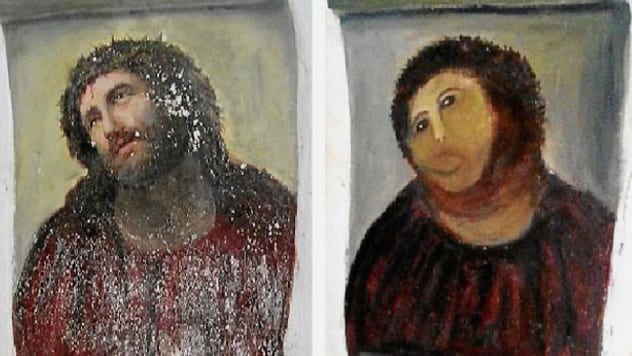
This is one that most people are somewhat familiar with, and it has everything to do with how spectacularly bad the final image became. The painting has come to be known as the “Monkey” image, but it didn’t start out that way.
Before the self-titled amateur art restorer, Cecilia Giménez got her hands on it, the fresco painted by Elías García Martínez was called Ecce Homo (Behold The Man), and it featured a lovely image of Jesus Christ. Unfortunately, time and the elements had damaged much of the fresco, and it required restoration.
Giménez saw the fresco and wanted to repair it to preserve the lovely church in which she was married, so she began working on the painting with no formal restoration training, whatsoever. She coated it with thick blobs of color, which gave it a globby look it now features.[1]
Unfortunately… or fortunately, depending on how you look at it, she wasn’t able to finish. She had to leave town, and while she was away, the local historical association saw what she did. Mrs. Giménez became infamous and also Internet-famous.
On the plus side, she significantly boosted tourism in her town, as people come from all around to see the travesty.[2]
9 “The Virgin Mary And Baby Jesus”—Sudbury, Canada
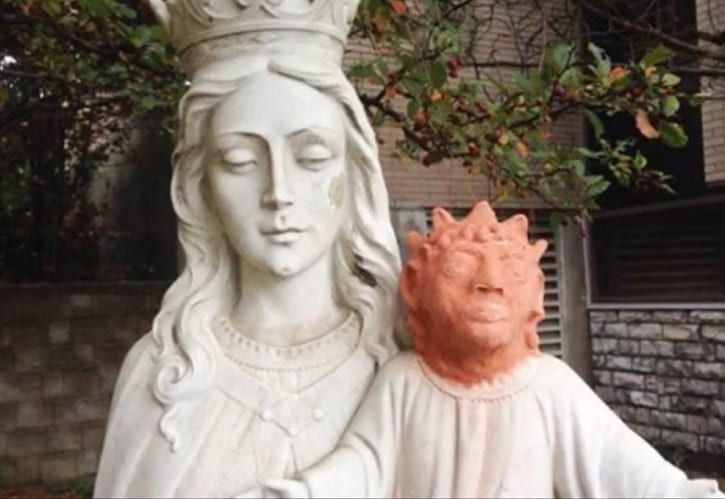
A sculpture of the Virgin Mary and Baby Jesus was vandalized, and someone broke off the head of the infant. This left a decapitated child sitting in His mother’s lap. While the original head was gone, numerous photos existed, so a restoration was attempted.
An artist named Heather Wise volunteered her services in making the new head. She got to work, and while there were plenty of pictures to go off of, the head she created looked nothing like the original sculpture.
More than that, it didn’t exactly look human either. What was once a beautiful statue became a frightening example of what not to do when it comes to restoring broken statuary.
The head is cartoonish in its appearance, and it’s made of terracotta, so it doesn’t match the statue in any way. She was planning on crafting the new head from stone but spent a single afternoon creating the monstrous head as a placeholder.
Fortunately, the story went viral, and the thief returned the original head, so Wise’s “restoration” was quickly removed to allow for a proper restoration.[3]
8 The Great Wall Of China
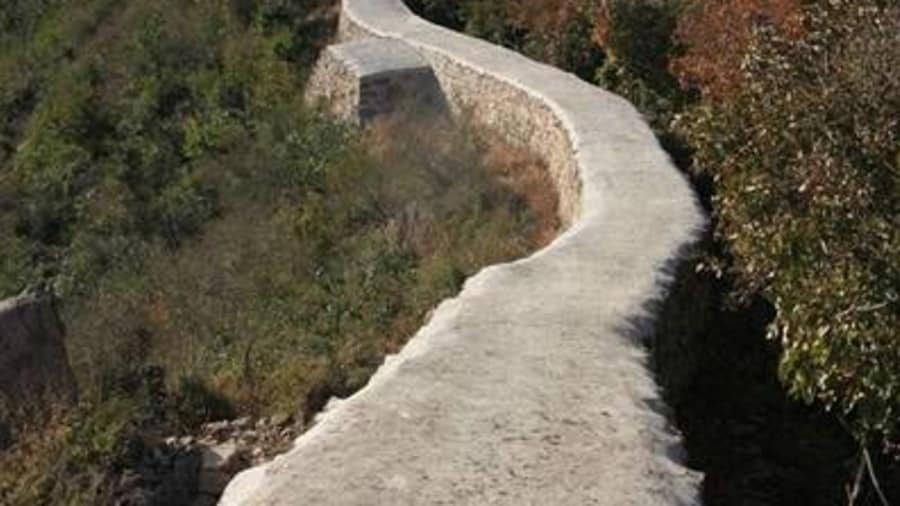
Many portions of the Great Wall have succumbed to the ravages of time… and the Mongols. Still, China has spent a great deal of time and money, preserving various sections for prosperity and the benefit of tourism. Some restorations have made the wall look as it did originally while others… not so much.
One of the most beautiful sections of the wall that received a massive “fail” in terms of restoration efforts came in 2016. The restoration’s goal was to maintain the pristine look of the wall, but keep it from crumbling. The result was a mess.
The 780-meter-long portion of the wall wasn’t rebuilt using any of the original pieces of stone. Instead, it was paved over with concrete. The smoothed out top of the wall is less of a restoration and more of a complete and total destruction.
The long section of wall no longer looks anything like it once did. Instead, it looks more like a slightly elevated sidewalk with no historical context whatsoever. Fortunately, this particular instance of “restoration” came under investigation, and future projects relating to the Great Wall will fall under greater scrutiny.[4]
7 The Beard Of Tutankhamen’s Death Mask
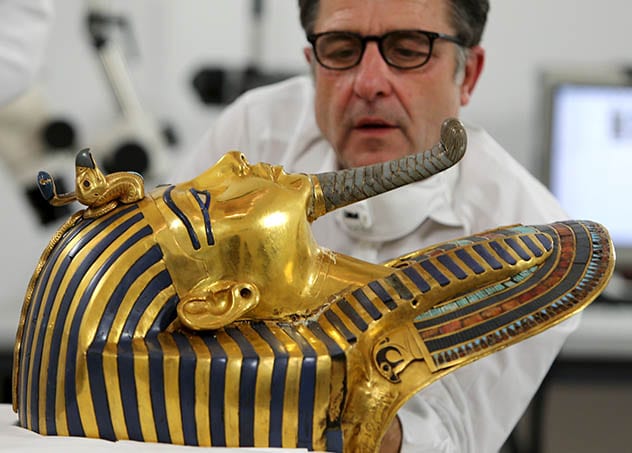
The Mask of Tutankhamun is arguably one of the most beautiful and best-known artifacts and works of art in the world. The mask was found in 1925 in the young pharaoh’s tomb, and it is a beautiful example of skilled ancient artistry.
When it was found, the mask was already 3,248 years old, but it was in pristine condition. Unfortunately, that didn’t last long, and in 2014, the beard broke off, and the mask had to undergo restoration efforts to preserve it.
The plaited beard weighed in at 5.5 lbs. (2.5 kg), so reattaching it required the knowledge and skills to make sure it was done properly. Instead, the museum staff hastily glued it back onto the mask in as inexpertly a way possible.
The repair resulted in more damage, and it was done so poorly, the people involved were charged with negligence and violating professional standards over the incident. Their “work” in fixing it left deep scratches and gouges where they tried to remove built-up glue.
Fortunately, a team of experts out of Germany was able to work on the mask in 2015. Their work repaired the damage and reattached the beard properly.[5][6]
6 The Castle Of Matrera, Spain
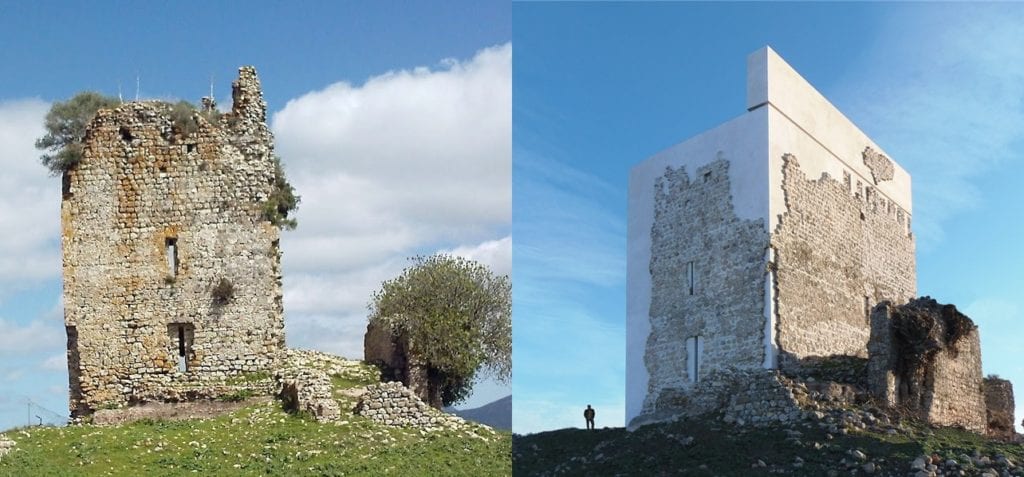
Restoring ancient buildings is no easy task, but there is a proper way of doing it, and there is the Castle of Matrera way of doing it. The castle was built in the 9th century to defend Iptuci, and by the 13th century, it had been rebuilt, though it fell to ruin in the intervening years.
In 2010, the castle still stood, but only barely. A few walls remained standing, and the remaining ruins were damaged by the weather, so a restoration project was launched. At its head was architect Carlos Quevedo Rojas, who managed the project for five years until it was completed in 2015.
His goal was to “recover the volume, texture, and tonality that the tower would originally have had. The essence of the project is not intended to be, therefore, an image of the future, but rather a reflection of its own past, its own origin.”
The end result absolutely enraged the locals, who saw the ancient castle as completely ruined. Spain’s cultural heritage organization Hispania nostra called it “absolutely terrible.” Architecturally, it was done well, but culturally and historically, the national monument was all but destroyed.[7]
Top 10 Controversial Statues Around The World
5 “Saint George And The Dragon”—Estella, Spain
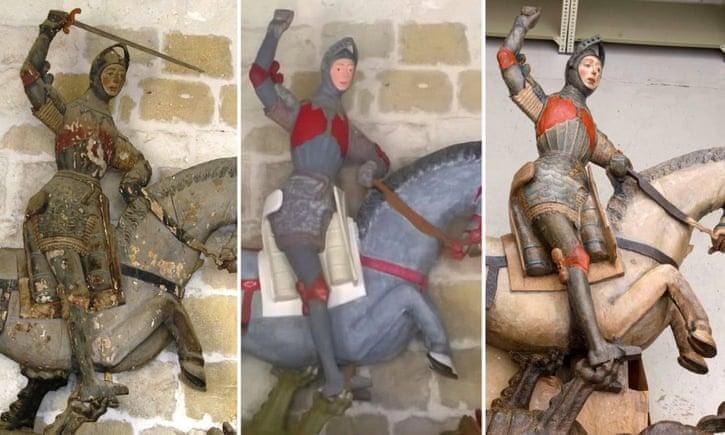
The Church of St Michael in Estella, Navarre is the home of a 16th-century polychrome statue of Saint George and the Dragon, but after centuries, it fell into disrepair. The color had largely faded, so restoration efforts began in 2018.
A local artist was called upon to repair the statue, but the end result looked nothing like how it was supposed to. Instead, it had a largely cartoonish appearance, which left St. George with rosy cheeks, making him appear more like Tintin than St. George.
The restoration was a disaster, and it was done so poorly, the statue had to be “unrestored,” so that it could be properly restored later. Painstaking work had to be done to undo all the damage done in the initial restoration. Still, after 1,000 hours of work, it was mostly fixed.
Much of the original paint was lost in the restoration/unrestoration/restoration effort, but the statue looks better than it did before any attempts were made to fix it. Ultimately, a restoration that should have cost around €10,000 cost closer to €33,000. On top of that, the archdiocese of Pamplona was forced to pay a €6,000 fine for the damage.[8]
4 “Santa Bárbara”—Fortaleza De Santa Cruz, Brazil
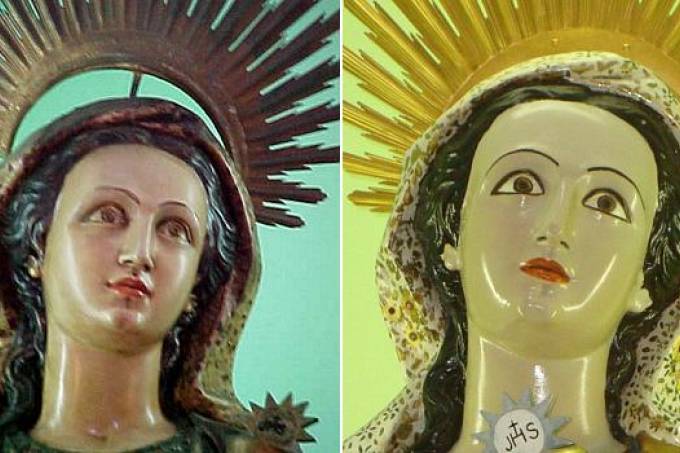
The Santa Cruz da Barra Chapel was once home to a 19th-century wooden statue of Santa Barbara, and by 2012, it needed restoration. Over time, the paint had faded, so conservators from the Museu Histórico do Exército in Rio were tasked with restoring it.
They spent six months detailing the statue to bring it back to its former glory, but the end result was far from what the chapel wanted. The restorers removed four layers of paint, which they replaced with an odd coloration that’s been described as Barbie, not Santa Barbara.
The statue received what can only be described as a bad makeover. The skin was colored white, and it was given an excessive amount of eyeliner. The robes were garishly colored, making the statue look out of place in a chapel.
The worst part of the restoration was that it wasn’t needed — at least, not to the extent that was done. At most, it needed a thorough cleaning with some touch-ups. Instead, the restorers completely stripped and repainted the statue, destroying its original beauty in the process.[9]
3 “St. Anthony Of Padua,”—Soledad, Colombia

A wooden statue of San Antonio de Padua in Soledad, Colombia, was in need of restoration in 2018, as the coloring had largely faded. Structurally, the statue was sound, but without the proper coloring, it had lost much of what made it stand out in the chapel.
The statue was carved in the 17th century, so it had some wear and tear by the time the church managed to commission an artist to repair it. That’s an artist, not a professional restoration expert, and there is a difference.
The work that the artist did certainly restored the statue’s vibrancy, but not in a way that the parishioners appreciated. Comments surrounding the work often labeled it as “too effeminate,” It looked as if San Antonio was wearing makeup.
Indeed, a close-up examination of the statue makes it look as if he’s wearing shiny lip gloss, eyeshadow, and additional coloring on his cheeks. One parishioner described the statue, saying, “He is no longer the same patron that I have prayed to for the last 12 years, they applied eye shadow, blush and even gloss on his lips, he looks effeminate.”[10]
2 Ocakli Ada Castle, Sile, Turkey
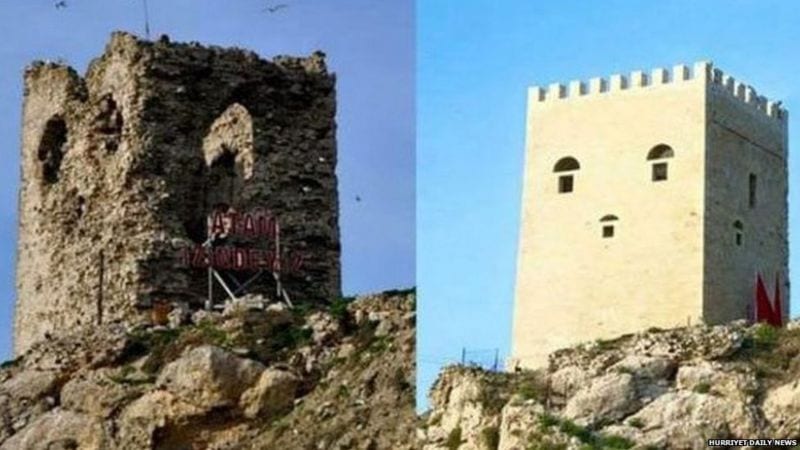
The Ocakli Ada Castle in Sile, Turkey, was first constructed as a watchtower, which was built some 2,000 years ago by the Genoese. The castle was eventually conquered by the Ottoman Empire in 1396, and it has undergone two separate repairs/restorations over the years.
The most recent restoration attempt was completed in 2015 following major renovations, but it looked … different. Gone were the stones used to construct the castle millennia ago, and in their place, a sleek, shiny new building appeared.
The new castle may look something like it once did (had it been constructed using modern tools 2,000 years ago), but it no longer resembles the tower it once was. What it does resemble, according to the masses on the Internet, is Spongebob Squarepants.
When the restoration was revealed in 2015, that’s all anyone could say about it online when the story went viral. The original castle was arguably destroyed and replaced with a new one, but the local municipality has defended the project.
Professor Kemal Kutgun Eyupgiller, who worked as an advisor on the project, said in a statement, “What needs to be criticized here is the neglect that the castle suffered since the 19th Century.”[11]
1 Buddhist frescoes, Chaoyang, China

The 270-year-old Yunjie temple in Chaoyang, China, was once home to some beautiful Qing Dynasty frescoes, but time had worn them mostly away. What remained were the figures, but most of the coloring had faded long ago. They were a classic example of the period, and restoration was attempted in 2013.
Instead of restoring the original images, it seems the restorer took it upon themselves to completely paint a new image over the faded one. While that might have been somewhat acceptable had it been in the original painting style, that’s not what happened.
The new fresco looks like a cartoon. It uses bright colors more reminiscent of something you might see in a Disney movie, but that’s actually giving them too much credit. The original paintings were destroyed, and the new ones were a painful reminder of what was lost.
An official in charge of temple affairs and another working as the head of the cultural heritage monitoring team in Chaoyang were sacked over the unauthorized restoration. Unfortunately, the damage was done, and the original frescos are completely destroyed.[12][13]
10 Monuments More Controversial Than The Confederate Statues








